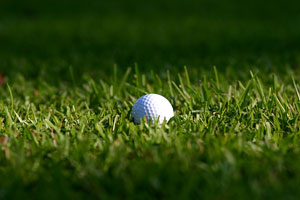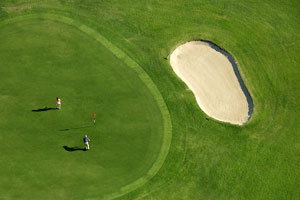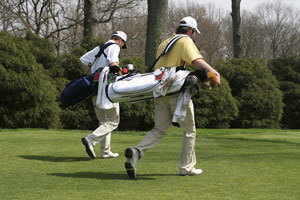
Golf
Sports Information Menu |
|---|
| Archery • Baseball • Basketball • Bowling • Cycling |
| Football • Golf • Hockey • Lacrosse • Paintball |
| Racquetball • Rock Climbing • Scuba Diving |
| Skateboarding • Skating • Skiing • Soccer |
| Softball • Squash • Surfing • Tennis • Volleyball |
 Golf is a popular recreational and professional sport worldwide,
dominated by tournaments such as the PGA Tour and the Masters.
Utilizing a club and ball, the object is to play the ball from the starting point to the hole in as few strokes as possible.
Golf is a popular recreational and professional sport worldwide,
dominated by tournaments such as the PGA Tour and the Masters.
Utilizing a club and ball, the object is to play the ball from the starting point to the hole in as few strokes as possible.
Recent Golf News
- Paige Spiranac has theory for plummeting Masters ratings
There are lots of possible reasons why this past week's Masters tournament was one of the lowest-rated in recent memory, but golf influencer Paige Spiranac has her own theory.
Fox News. Thursday, 18 Apr 2024 19:13:50 -0400. - Portland company makes unique bag for golf legend Jack Nicklaus
Jack Nicklaus's golf bag that he had at the 2024 Masters Tournament is getting a lot of attention, and it's all thanks to a Portland company.
Joe Raineri. American City Business Journals. Thursday, 18 Apr 2024 22:42:24 +0000. - Visit this golf news page for more extensive news coverage.
There is no consensus on the exact origins of golf, but similar games were played in Rome, Belgium, France, and Scotland. Golf in the United States was chiefly a game of social status before 1913, but tournament golf gained wider attention after a former caddie named Francis Ouimet won a U.S. Open Championship. It reached peak popularity in the 1920s and there are currently over 16,000 golf courses in the United States alone, with over 26 million people playing golf at least once a year.
 The golf course is usually between 5,000 and 7,000 yards in length, and
divided into 18 holes which are 100 to 600 or more yards apart.
Each hole features a flat teeing ground, a fairway 30 to 100 yards wide,
a green, or putting surface, and a hole 4.25 inches in diameter marked by
a flag. Each hole may also have sand traps, ponds or streams,
ditches, and natural features such as trees, rocks, and shrubs; all of
which make the course more unpredictable and challenging.
The golf course is usually between 5,000 and 7,000 yards in length, and
divided into 18 holes which are 100 to 600 or more yards apart.
Each hole features a flat teeing ground, a fairway 30 to 100 yards wide,
a green, or putting surface, and a hole 4.25 inches in diameter marked by
a flag. Each hole may also have sand traps, ponds or streams,
ditches, and natural features such as trees, rocks, and shrubs; all of
which make the course more unpredictable and challenging.
In "stroke play," the number of strokes for the course is counted, and the player with the lowest total wins. This is the type of scoring used in professional tournaments. An alternative scoring method is "match play," in which the players or teams track scores at each hole, with the ultimate winner being the team which wins more holes than there are holes left to play.
 The ball must be played as it lies from the tee to the hole. The
player whose ball is furthest away from the hole takes the first
turn. "Par" refers to the number of strokes a first-class player
should take on a hole in optimum conditions. One stroke higher than
par is known as a "bogey," one shot lower than par is a "birdie," two
fewer strokes is an "eagle," and three strokes less than par is known
as an "albatross" or "double eagle." Amateur golfers may play with
a "handicap," which is the average number of strokes above par of a number
of previous rounds.
The ball must be played as it lies from the tee to the hole. The
player whose ball is furthest away from the hole takes the first
turn. "Par" refers to the number of strokes a first-class player
should take on a hole in optimum conditions. One stroke higher than
par is known as a "bogey," one shot lower than par is a "birdie," two
fewer strokes is an "eagle," and three strokes less than par is known
as an "albatross" or "double eagle." Amateur golfers may play with
a "handicap," which is the average number of strokes above par of a number
of previous rounds.
Most golfers play right-handed, even those who are left-handed in daily life. This is due in part to the difficulty of finding left-handed clubs, and largely because of the awkwardness of golfing left-handed. To begin a golf swing, the player stands with the left shoulder and hip pointing in the intended direction of ball flight. For right-handed players, the club is held with right hand below left, with the club head resting on the ground behind the ball. Hips and knees should be gently flexed. The golfer then shifts body weight to the right side, turning pelvis and shoulders while lifting the arms and flexing the elbows and wrists. This is known as the "backswing" and ends with the hands above the right shoulder and the club pointing in the intended flight direction. The backswing is followed by the "downswing," which is a reversal of the backswing. The downswing ends when the ball is struck. The next step is "follow-through" which consists of continued rotation to the left, ending with the body weight almost entirely over the left foot, the body turned to the left, and the club hanging down behind the golfer's left shoulder. A correct golf swing is complicated, and even professionals spend much of their time practicing the swing.
When a golf ball is hit, it acquires "spin," most commonly "backspin," which gives it an upward force enabling it to fly higher and longer than a ball without spin. "Sidespin" is a technique used by accomplished golfers to steer the ball around obstacles by causing the ball to curve to the left, a "draw," or to the right, a "fade." If "sidespin" is not successful it may result in a "hook" (sharp angle to the right), or a "slice" (sharp angle to the left).
There were originally 13 rules of golf which eventually became 41 rules of etiquette. These include replacing divots (chunks of grass and dirt lifted by a golf swing), and letting two-player matches take precedence. A cry of "Fore!" is common courtesy to warn other players of a wayward ball. The penalty for breaking a rule is usually 2 strokes. A golfer may carry no more than 14 clubs and may employ a caddie, who will carry the clubs. If a ball is lost or unplayable, another ball is played from the place of the original stroke, and a penalty stroke is added.
The golf ball has a minimum diameter of 1.68 inches and a maximum weight of 1.62 ounces. It has a core wound with elastic thread and covered in a dimpled plastic casing. Golf tees are usually made of wood or plastic and resemble a nail with a cup on the head. Different types of golf clubs are used depending on the objective. The three major types of clubs are woods, irons, and putters. Woods are used for distance shots, irons are used for precision shots, and putters are usually used on the green to "putt" the ball into the hole. Golfers typically wear special shoes with soft spikes on the sole, active sportswear, and gloves that help grip the club; usually one on the left hand for a right handed player or the right hand for a left-handed player. Sometimes special golf carts are utilized to provide transport around the course.
Variations on traditional golf include "miniature golf," which is a putting game on fancifully designed courses. It became widespread in the 1930s and is a popular recreation for kids and adults alike. Putting greens and driving ranges are also popular means of recreation and practice.
Golf Information Resources
- USGA Rules of Golf
- NCAA Men's Golf
- NCAA Women's Golf
- Professional Golfers' Association
- Ladies Professional Golf Association
All rights reserved. About Us.